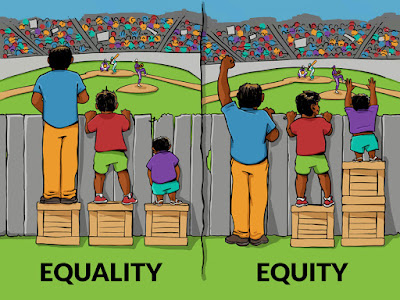Encouraging diversity in science
Should we use quotas
After reading this blog post on women participation in computer science I was left puzzled by the argument that equal opportunity is all we need. Fortunately, Twitter was here to the rescue, with colleagues pointing me in the right direction. I must mention here the post from Lorena A Barba that is way more detailed that was I'm summarizing here. Just to get to the point, I tried here to simply put down the two approaches, arguments and counter-arguments. I focus on men and women differences, but I guess this applies equally to any unrepresented social group.
Equality vs Equity
The idea of 'equality' is that we can increase diversity using incentives and by removal of artificial barriers. This is the reasoning behind promoting equal opportunity for all.
The idea of 'equity' is that we can increase diversity by changing structures that lead to differences in outcomes. This is the reasoning behind promoting equal outcomes for all.
Equality arguments
There are many factors that influence outcomes, and focusing on a marginal effect cannot account for the observed effect. Concretely, it means that e.g. there are many factors that explain why men and women have different salaries, and gender per se is just one of them. Yes that this is likely true, but if we were to quantify this (which I haven't researched) I'm pretty sure gender itself would account for a huge amount of the variance, so the multifactorial argument is not good enough.
Another argument is that men and women are different for biological and cultural reasons and that many workplaces are biased toward men values and interest (for historical and cultural reasons). An observed difference in outcome in our modern societies, say e.g. the percentage of women in position, is, therefore, a reflection of women free choice, since we offer equal opportunities in hiring.
Equity arguments
There is no such a thing as free choice. Choice in adulthood is mostly driven by social expectation and cultural pressures translated in parental guidance and education. This means that the choice made by women to not enter STEM is not a reflection of their 'natural tendencies' (even if these truly existed) but a reflection of an enforced stereotype that they are not good at it. Such stereotypes appear from age 3 to 5, and the bias for STEM has been observed from age 6. Of course, stereotypes are useful to develop and interact socially, but negative traits are not useful in stereotypes, in fact, they have been shown to impede cognitive performance.
Equal opportunity assumes that facing two candidates with equal merits, each candidate has the same chance. While in theory, this is nice, this discards all the evidence on the implicit bias which tells us that chances are not equal. This also means that we have objective ways to measure merit, which is simply not the case. This implies that to fix social unbalance we need quotas because equal opportunity does not exist (by the way quotas have also been linked to increased performances, and do not 'lower the bar' since you remove the worst men performers for the best women).
Conclusion
In theory, equal opportunity is what we want. In practice, because of stereotypes in our society that drive choices (to enter a career or to select a candidate), and of too often poor measures of merit, equity (quotas) if what we need - until negative traits in stereotypes disappear.



Comments
Post a Comment